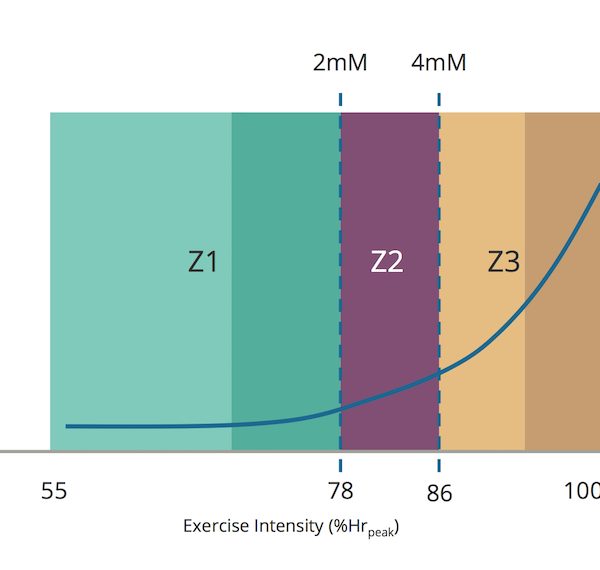Training intensity distribution (TID) is the amount of time spent at different training intensities or zones. In the scientific literature on endurance athletes a 3 or 5 zone model is most commonly used when determining TID, however, studies will also measure intensity based on a percentage of functional threshold power or heart rate. In endurance sports culture endurance athletes have heard of different periodization models such as polarized and perhaps also pyramidal. It is how these models are measured which can lead people to misunderstand how to best use them in creating training for their personal goals. In this article, we will discuss what these two periodization models are, why they become misunderstood, practical implications for how you can properly use them, and also perhaps when it may not matter which one you use.
Polarized
The polarized training model is the period of training that consists of an intensity distribution which can be demonstrated with a large amount of training in zone 1 (assuming a 3 zone model), a small amount of training in zone 2, and a medium amount of training in zone 3. It can also be imagined to be in the shape of a backward “J” with intensity on the X-axis and time on the Y-axis. This model has a lot of hype and acceptance in endurance sports.

Pyramidal
The pyramidal training model is the period of training that consists of a distribution that can be demonstrated with a large amount of training in zone 1, a medium amount of training in zone 2, and a small amount of training in zone 3. It can be imagined to be in the shape of the right half of a pyramid with, again, intensity on the X-axis and time on the Y-axis. This model is not the most well-known but is actually the most commonly used when training is done using time instead of sessions or workouts, but we’ll get into that next.

Models Misunderstood
A lot of studies in the past, perhaps most, have used a zone model system for assessing the intensity of workouts. This can lead to readers such as lay people who may not dig into the results of the studies that include time-based information to determine their training is best created using zone-based workouts and a polarized model. For athletes looking to take their training and fitness improvements seriously, this may be a gross misinterpretation of how much time they would ideally spend at different intensities which can look very different depending on the phase of training a given athlete is in. In other words, what may be a polarized model an athlete follows using session-based training may not be a polarized model using time at given intensity-based training.
“What’s most common is endurance athletes performing their best spend as little as around 70% of their time at zone 1 to upwards of 95% of their time in zone 1…”
The reason this understanding is important is that it delves into the nuance required to understand TID so you are not only more confident in your training prescription but you know what is actually objective and best for you. What studies have shown is when time is measured virtually all well-trained and elite endurance athletes, across different sports, follow a Pyramidal model of TID. While in theory, it’s possible for there to be a wide variance, what’s most common is endurance athletes performing their best spend as little as around 70% of their time at zone 1 to upwards of 95% of their time in zone 1, while most commonly around 90%. Obviously, this doesn’t leave much room for endurance athletes to train at higher volumes in zone 2 or zone 3 for that matter.
Practical Implications
Athletes who use a bike computer or running watch and wear a heart rate monitor or power meter will be able to see on their respective platform the amount of time spent exercising at given intensities on a daily, weekly, monthly, or even yearly basis (not that that’s the most useful). To drive home what you want to remember is studies on TID are highly likely to actually represent a pyramidal model when measured by time instead of quantity of sessions. When you review your past data here are some questions I would ask yourself:
- Do I have a chart that shows time spent at different intensities?
- What are the heart rate or power ranges that make up the different intervals (bars, dots, or other)?
- What does the shape of the data on the graph look like? U? Backwards J? Or other?
- Is the shape of the data, indicative of your TID, appropriate for your phase of training which could be a week, month, or specified duration block of training?
- How can you change your workouts to be more suitable to your needs on a weekly basis? Keep in mind it’s best to spend a slightly higher percentage of time at higher intensities or zones such as 2-6 weeks prior to an important race. More sustained than this you will risk overtraining symptoms.
When
Recreational athletes don’t typically utilize modern training programs that analyze their data, or at least they aren’t equipped with the knowledge of how to use the data. Additionally, studies have shown that recreational athletes benefit from any amount of endurance training regardless of the model used. As their volume increases it’s best to adopt a pyramidal model. What is defined as a recreational athlete you ask. Well, it’s not objectively measured among the scientific community from what I could find, however, studies have demonstrated endurance athletes begin to show greater increases in performance when their weekly training volume is consistently above 5 hours.
Conclusion
Optimal TID practices can be simplified for whether you’re a recreational or an elite endurance athlete. It can be simplified to remember that if you’re training with enough frequency and focus that you’re using software to look at your data perhaps that’s when it may be worth considering looking at what shape your weekly TID takes. Otherwise, if you’re not competing or don’t want to look at data then just continue to have fun out there!
About the Author:
Coach Carson is a dedicated athlete and coach based in Tasmania, Australia who specializes in cycling, strength and conditioning, and finding a balanced and sustainable approach for his athletes. For more information on Carson’s coaching services, or to schedule a coaching consultation with him click HERE.
Resources:
https://pubmed.ncbi.nlm.nih.gov/25803237/
https://pubmed.ncbi.nlm.nih.gov/23752040/
https://pubmed.ncbi.nlm.nih.gov/11740304/
https://pubmed.ncbi.nlm.nih.gov/30381001/
https://pubmed.ncbi.nlm.nih.gov/33344993/
https://pubmed.ncbi.nlm.nih.gov/31827355/
https://www.ncbi.nlm.nih.gov/pmc/articles/PMC4621419/
https://www.acc.org/latest-in-cardiology/articles/2016/06/27/07/06/the-terms-athlete-and-exercisers




